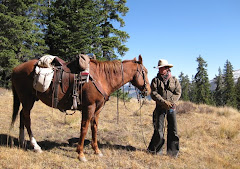
Elsewhere, your thoughts, your pasture, your warm air may be turning to spring. Your trees may be swelling, budding, in bloom, or already leafing out. Your horses may have already shed, feet trimmed, and now are getting in shape for the season ahead.
Here our world remains white. Winter remains. I reflect back upon post from earlier this winter, originally posted on the High Mountain Muse site.
I know spring is coming, though it may be harder to see here. Our mare, Tres, the first of the season due to foal, has been led off the mountain into caring hands where we anticipate a new life, a healthy colt, soon, so very soon…
In the meanwhile, I share this with you about the world from which she just descended, the world in which we still remain.
The horses’ coats are thick and heavy. Shaggy, fuzzy horses. Wild beats to look at. Even their winter coats do not keep the cold from penetrating their skins, chilling them deep within. Frost builds up on their eyelashes and at the base of their tail. Small opaque icicles form around their muzzles.
Here our world remains white. Winter remains. I reflect back upon post from earlier this winter, originally posted on the High Mountain Muse site.
I know spring is coming, though it may be harder to see here. Our mare, Tres, the first of the season due to foal, has been led off the mountain into caring hands where we anticipate a new life, a healthy colt, soon, so very soon…
In the meanwhile, I share this with you about the world from which she just descended, the world in which we still remain.
The horses’ coats are thick and heavy. Shaggy, fuzzy horses. Wild beats to look at. Even their winter coats do not keep the cold from penetrating their skins, chilling them deep within. Frost builds up on their eyelashes and at the base of their tail. Small opaque icicles form around their muzzles.
I wonder if they know this cold spell will not last but a day or two. Temperatures will warm. Mornings will return to around zero. A noticeable difference from twenty below zero, as we have this morning.
In the mornings the air is as still as the ice. Sometimes I think you can almost see the frozen water in the air.
In the afternoons, the wind blows strong and violent as the sun slides behind the slope of Ute Ridge. It is early, not even 4 o’clock as the sun silently slips away for the day, the signal which warns us to prepare for nighttime. I finish my outside chores as the thermometer’s figures drop before your eyes if you had nothing better to do than watch. Keeping busy keeps you warm.
The horses huddle in the wind. A mass of many, all with their rear ends to the wind. From one another, from the position of their hearty yet so fine and delicate bodies, they find simple protection from the elements. They remain out in the open. I wonder why they don’t seek the shelter of the sheds. Deep inside, they are still animals of the plains. They are still wild as that wind. More so in the winter, when they are allowed to be here, forced to be here.
Wild, or so very domesticated, as they have been for thousands of years, our companions, our partners, our beasts of burden, of transport, of war. They have changed the life of man. They have certainly changed my life.
Who says horses can not tell time? They are as punctual as I am. Usually more so. They watch in the direction from where they expect me to arrive, anticipating their next meal that they know will be… soon, so soon, never soon enough. Like so many sun dials if I were the sun. I suppose my presence, that which brings promise of hay, is nearly as welcome as the rising of the sun.
We feed heavy. Calories are heat. An apparent conversion. Extra hay and a concentrated pelleted feed. They endure, heads down, eyes not meeting with mine. Just surviving. They will eat. This will pass. They will make it through.
Only my little stallion seems to suffer. Born in California and raised in a protected stall, he seems to find this all so wrong. I think at times he is right. His coat is as thick as those born here, those who accept the cold blasts and biting winds without visible concern. It is an expected and tolerable part of life for them. As if they shrug their shoulders and acknowledge that which they can not change.








